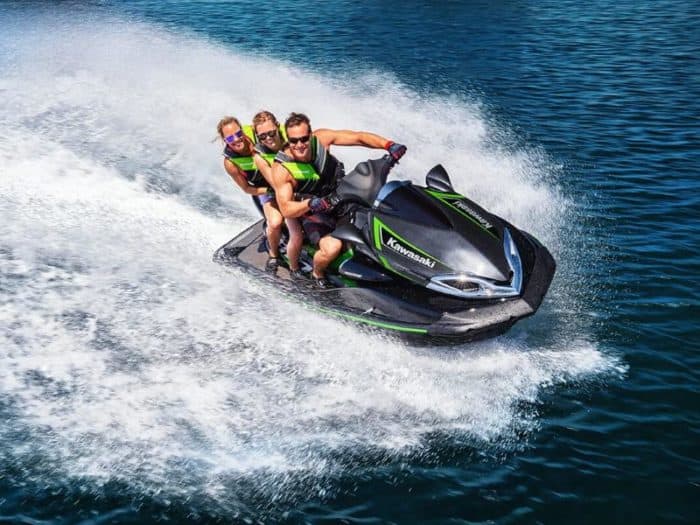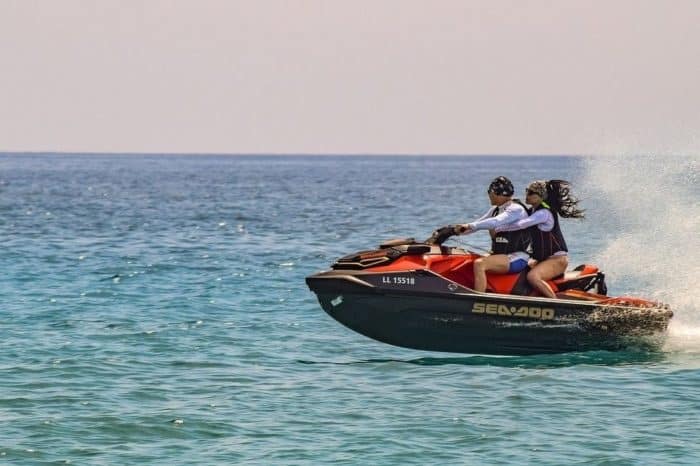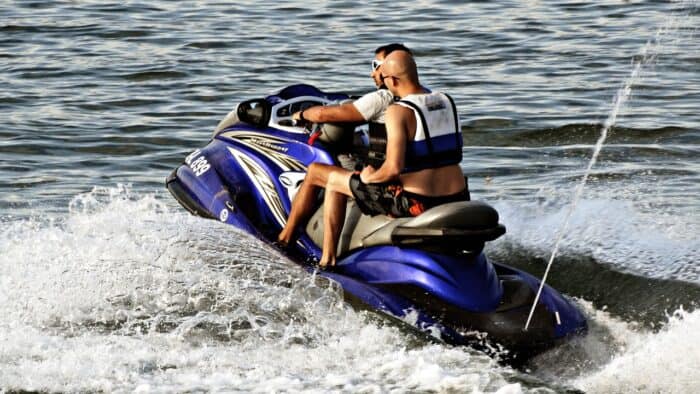What is the Best Way to Check for Gas Fumes After Fueling a PWC?
The best way to check for gas fumes or a gas leak after fueling your PWC is to check the engine compartment by smelling for any trace of fuel odor. A thorough check will also involve an inspection of the gas tank and fuel lines as well. If you smell gas fumes caused by leaking fuel you should never start your PWC’s engine.
Open the Door to the Engine Compartment

Gasoline has a distinct smell and you’ll need to hunt for that if you suspect you have a fuel leak in your PWC or if you’re just being cautious. The fuel cap is located on the left side of your PWC in most models, just to the side of the steering controls.
After you fill up the tank you should access the engine compartment and perform a simple sniff test to see if there is a smell of gasoline.
Oddly enough, a lot of casual personal watercraft users and people new to PWCs don’t actually know where the engine compartment is or how to access it, but you should always be familiar with the machine you’re using before you head out on the water, just in case.
The engine compartment is accessed under the seat on a PWC. There should be a latch or button depending on what model you’re using that will allow you to flip the seat up or remove it entirely to gain access to the engine below. This is good to know for cleaning purposes as well since you’ll need to get in there to clean this out.
Make sure the PWC engine is off before you open the compartment up to take a look. It should go without saying that you never want to fuel it while the engine is running, either.
Since the compartment is small and isolated if there is a fuel look the smell should be noticeable the moment you pop the compartment open. In my personal experience I’d recommend waiting a minute or two after fueling to do this check because you may be getting some residual smell from the gas you just put in if there was any fuel spillage around the gas cap or got on your hands or anything like that. So give it a second to dissipate if it’s out in the open.
When you open the compartment if you definitely smell gas then you know you have a leak somewhere as it shouldn’t be noticeable in there at all, or certainly not strongly.
Pop open the gas cap again if you smell fuel in the engine compartment and see if you can smell gas coming from in there and if it is as strong, more strong or less strong than what you’re getting around the engine. Don’t start the engine at all if you are getting fumes as there’s a risk of a serious accident at this point.
You may also want or need to check your fuel filter but this is a far more in depth process. If it’s cracked or clogged, it could be causing the leak you’re smelling. This is best done by a professional unless you’re pretty confident in your skills.
Fuel Lines

Because gas leaks can occur in more than one spot, you can go for a more in-depth inspection of those gasoline fumes to determine where the leak may be before you proceed with looking into how to repair it. You’ll need to know this information anyway, so best to get it done now. The fuel system is not that big so you really only need to inspect the gas tank and the fuel lines themselves.
Factory fuel lines in older PWCs have a bad habit of breaking down and deteriorating. The fuel line can begin to wear thin and crack, and they also start producing a build up of a green goo in the lines that can really cause havoc in your PWC by clogging up the lines and damaging your engine as well. If you have old, gray fuel lines in your PWC you may want to consider swapping them out even if they aren’t leaking.
When it comes to checking for fumes from the lines you can take a look into the engine compartment where you did the sniff test and look for the lines that run from the tank to the engine itself. If the compartment is wet from being used in the water already it will be hard to visually notice a leak, but if it’s still dry this is a great way to check by just seeing if there is any moisture to accompany the fumes.
You’ll want to inspect where the lines are connected or if there are bends and especially visible cracks in the lines. Use your fingers if necessary to feel where the moisture is accumulating and you can do another sniff test. If you smell gas on your fingers you have your answer.
If you think you see a leak but aren’t smelling gas fumes, try starting the engine and just let it idle for a minute or two. Shut it off and then inspect the engine compartment again. If you smell gas this time, keep the engine off and get the PWC to a mechanic or someone able to give it a more thorough inspection and repair job.
If you’re not smelling anything after letting the engine idle then you should be good to go and enjoy your PWC.
Inspect Around the Gas Tank

Doing a sniff test on the gas tank itself is never an easy task since it’s obviously holding gas. If there is a leak around where the gas cap is sealed it can be hard to notice this specifically and you’ll need to get inside to take a look since the sniff test will let you know there’s a leak but not where. Not every model of PWC makes it easy to do this but if you can flip over the frontside of the steering column to take a look, or if the tank is located in the compartment under the seat, you may be able to do this.
For PWCs that have an engine compartment under the seat and a fuel compartment in the front you may have an easier time tracking your leak but you may need to be fast since everything is connected. If one compartment smells more strongly of fuel than the other you can narrow down where the leak is. It may be directly from the gas tank or it may be where the fuel is supplied to the engine. But if you leave both compartments open to check, it’s possible the air circulation will make it harder for you to figure out what you’re looking for.
How Often Should You Check for Fumes?

This question goes hand in hand with how to inspect for fumes and a lot of casual and first time users want to know how often you need to inspect for gas fumes. Since this is a matter of safety the answer is literally every time you fill up.
Now I know a lot of PWC owners and riders don’t follow this rule every time, but you really should. It takes a minute of your time and can prevent a serious accident. PWC’s are notorious for accidents because so many people are not cautious about using them properly. It’s always better to be safe than sorry.
Inspect Your PWC Safely

If you suspect a leak and you are smelling fumes, make sure you’re in a well-ventilated area and you’re allowing some airflow whether you plan to fix it yourself or you need to call in a mechanic to take a look. You don’t want to allow gas fumes to build up in a small space, and especially not a small space that you’re in as well. Make sure your PWC always has an extinguisher on board.
Make sure when you are filling up that you’re not spilling fuel anywhere and you’re not overfilling the tank. Overfilling can be a problem with some PWCs and the tanks are designed to not be fully filled so the fuel can safely expand in the tank.
The Bottom Line
Check your PWC for fuel leaks by doing a smell test to see if there are gas fumes present. Open the engine compartment after fueling and see if you can detect the smell of gasoline. If you don’t, your PWC should be safe to operate.
If you think you visually see a leak but don’t smell gas, try starting the engine and letting it idle, then do a smell test. If you smell gas, leave the engine off and get to a mechanic.
You can check leaks with your fingers and smell the residue to see if it smells of gasoline as you may have a minor leak that hasn’t gotten too bad yet. Smell around the fuel tank itself as well if you suspect or see signs of a leak around the tank or the gas cap. Never start your engine if you smell fumes in the compartment and get it repaired as soon as you can.
Categories: Personal Watercraft








